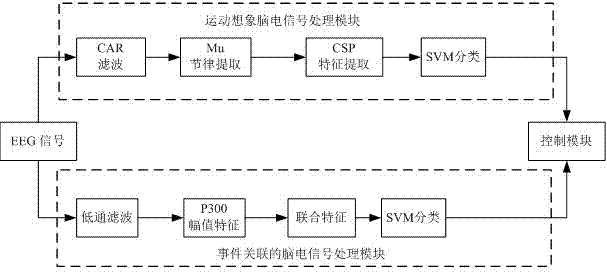Intelligent wheelchair based on multimode brain-machine interface
A brain-computer interface, multi-modal technology, applied in the patient's chair or special transportation means, user/computer interaction input/output, computer parts and other directions, can solve the problem of low practicability, inability to accelerate, decelerate and start , stop, visual fatigue and other problems, to achieve the effect of improving system information transmission rate, meeting real-time requirements, and increasing practical performance
- Summary
- Abstract
- Description
- Claims
- Application Information
AI Technical Summary
Problems solved by technology
Method used
Image
Examples
Embodiment
[0021] like figure 1 As shown, the intelligent wheelchair of the modal brain-computer interface includes a sequentially connected visual stimulation interface, an EEG acquisition platform, a multi-modal brain-computer interface, a control module, and an electric wheelchair. The subject wore a 32-lead electrode cap and sat on the seat of an electric wheelchair. The portable EEG acquisition instrument was placed in the wheelchair's back bag, and the vehicle-mounted notebook was placed on the wheelchair table. The visual stimulation interface was provided by the LCD screen of the vehicle-mounted notebook. The processing algorithm of the modal brain-computer interface module is provided by the vehicle-mounted notebook programming, and the communication unit and controller of the control module are fixed at the armrest of the wheelchair.
[0022] like figure 2 As shown, there are 5 P300 flashing keys in the visual stimulation interface, and the subjects can generate EEG signals b...
PUM
 Login to View More
Login to View More Abstract
Description
Claims
Application Information
 Login to View More
Login to View More - R&D
- Intellectual Property
- Life Sciences
- Materials
- Tech Scout
- Unparalleled Data Quality
- Higher Quality Content
- 60% Fewer Hallucinations
Browse by: Latest US Patents, China's latest patents, Technical Efficacy Thesaurus, Application Domain, Technology Topic, Popular Technical Reports.
© 2025 PatSnap. All rights reserved.Legal|Privacy policy|Modern Slavery Act Transparency Statement|Sitemap|About US| Contact US: help@patsnap.com



